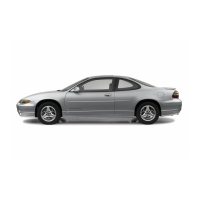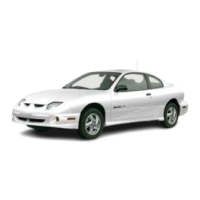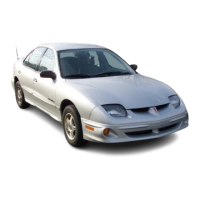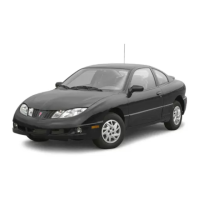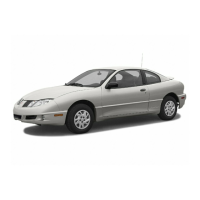Do you have a question about the Pontiac 2002 Sunfire and is the answer not in the manual?
Explains safety cautions and symbols used in the manual for hazard identification.
Details notices for things that could damage the vehicle, including potential warranty issues.
Describes symbols used on vehicle components and labels for operation and information.
Explains how to adjust front seats, seatbacks, and head restraints for comfort and safety.
Details proper safety belt usage, the Supplemental Restraint System (SRS), and essential safety precautions.
Addresses common queries regarding safety belt necessity, air bag interaction, and general safety.
Provides detailed instructions on wearing lap-shoulder belts correctly, including driver and passenger positions.
Explains the function and importance of the air bag system, emphasizing its use in conjunction with safety belts.
Highlights the importance of seat belt usage for rear passengers and how to wear lap-shoulder belts properly.
Covers manual and power window operation, including auto-down and lock-out features, with safety cautions.
Provides instructions for starting the engine in both automatic and manual transaxle vehicles, including safety notices.
Explains the function, setting, and safe usage of cruise control, including cautions for various driving conditions.
Provides an overview of the instrument panel components and their functions as an information system.
Details various warning lights, gages, and indicators on the vehicle, explaining their meaning and related actions.
Describes the air bag readiness light, its function in indicating system status, and the importance of servicing if it remains on.
Explains how to use the air system, including fan speed, temperature, and airflow direction controls for ventilation and heating.
Introduces the vehicle's audio system, its features like Retained Accessory Power (RAP), and how to operate it.
Explains how to find radio stations using tuning, seeking, and scanning functions.
Guides users on how to set and recall favorite radio stations using the six numbered pushbuttons.
Details the Radio Data System (RDS) features for displaying program information, traffic, and emergency alerts.
Emphasizes the importance of anticipating hazards, maintaining following distance, and staying alert to prevent accidents.
Discusses the severe dangers of drinking and driving, its effects on driving abilities, and legal implications.
Details the factors affecting braking action, including perception and reaction time, stopping distances, and road conditions.
Describes the function of the anti-lock braking system in preventing skids and its self-check procedure.
Covers challenges of driving in rain and wet conditions, emphasizing reduced traction, hydroplaning, and wet brake effects.
Details how to properly load the vehicle, including weight limits, tire loading information, and securing cargo.
Provides essential guidelines and safety rules for towing a trailer with specific engine and transaxle configurations.
Offers guidance on driving on steep grades, including proper gear selection for uphill and downhill driving, and engine cooling.
Provides detailed, safe procedures for jump-starting a vehicle with a dead battery using jumper cables.
Explains the causes and symptoms of engine overheating, including steam from the engine, and provides safety precautions.
Provides instructions on how to handle a tire blowout or slow leak, including steering and braking techniques.
Gives step-by-step instructions for safely changing a flat tire, including vehicle securing and tool usage.
Discusses fuel octane requirements, gasoline specifications, and the use of California fuels and additives.
Guides users on checking essential components under the hood, including engine fan safety and fire prevention.
Explains how to check engine oil levels, the function of the oil pressure light, and the importance of regular checks.
Details the recommended engine oil types, viscosity grades, and the significance of the starburst symbol for certification.
Details the vehicle's cooling system, recommended coolant (DEX-COOL), its benefits, and the importance of using the correct mixture.
Covers tire maintenance, including proper inflation, avoiding overloading, and recognizing when tires need replacement.
Explains the function of fuses and circuit breakers in protecting the vehicle's wiring circuits from electrical damage.
Provides approximate capacities for engine oil, transaxle fluid, cooling system, and fuel tank in English and metric units.
Details the scheduled maintenance services and their intervals, advising professional service for complex tasks.
Instructs users on how to choose between the short trip/city and long trip/highway maintenance schedules based on driving patterns.
Lists owner checks and services to be performed periodically to maintain vehicle safety and performance.
Lists periodic maintenance inspections recommended at least twice a year, covering steering, suspension, exhaust, fuel, and cooling systems.
Lists recommended fluids and lubricants by name, part number, or specification for proper vehicle maintenance.
Provides a template for recording maintenance services performed, emphasizing the retention of receipts for warranty purposes.
Explains the Pontiac Cares philosophy, highlighting benefits like warranty, customer assistance, and roadside assistance.
Outlines a procedure for resolving customer concerns, starting with dealership management and escalating to Pontiac Customer Assistance.
Explains the Pontiac Roadside Assistance program, its services, and enrollment for new vehicle owners.
Directs users to a separate warranty booklet for detailed warranty information.
Instructs on how to report vehicle safety defects to NHTSA and provides contact information for safety information.
Guides on how to notify General Motors about safety defects, providing contact numbers and addresses.
Provides information on ordering service manuals, unit repair manuals, and service bulletins, including pricing.
Explains safety cautions and symbols used in the manual for hazard identification.
Details notices for things that could damage the vehicle, including potential warranty issues.
Describes symbols used on vehicle components and labels for operation and information.
Explains how to adjust front seats, seatbacks, and head restraints for comfort and safety.
Details proper safety belt usage, the Supplemental Restraint System (SRS), and essential safety precautions.
Addresses common queries regarding safety belt necessity, air bag interaction, and general safety.
Provides detailed instructions on wearing lap-shoulder belts correctly, including driver and passenger positions.
Explains the function and importance of the air bag system, emphasizing its use in conjunction with safety belts.
Highlights the importance of seat belt usage for rear passengers and how to wear lap-shoulder belts properly.
Covers manual and power window operation, including auto-down and lock-out features, with safety cautions.
Provides instructions for starting the engine in both automatic and manual transaxle vehicles, including safety notices.
Explains the function, setting, and safe usage of cruise control, including cautions for various driving conditions.
Provides an overview of the instrument panel components and their functions as an information system.
Details various warning lights, gages, and indicators on the vehicle, explaining their meaning and related actions.
Describes the air bag readiness light, its function in indicating system status, and the importance of servicing if it remains on.
Explains how to use the air system, including fan speed, temperature, and airflow direction controls for ventilation and heating.
Introduces the vehicle's audio system, its features like Retained Accessory Power (RAP), and how to operate it.
Explains how to find radio stations using tuning, seeking, and scanning functions.
Guides users on how to set and recall favorite radio stations using the six numbered pushbuttons.
Details the Radio Data System (RDS) features for displaying program information, traffic, and emergency alerts.
Emphasizes the importance of anticipating hazards, maintaining following distance, and staying alert to prevent accidents.
Discusses the severe dangers of drinking and driving, its effects on driving abilities, and legal implications.
Details the factors affecting braking action, including perception and reaction time, stopping distances, and road conditions.
Describes the function of the anti-lock braking system in preventing skids and its self-check procedure.
Covers challenges of driving in rain and wet conditions, emphasizing reduced traction, hydroplaning, and wet brake effects.
Details how to properly load the vehicle, including weight limits, tire loading information, and securing cargo.
Provides essential guidelines and safety rules for towing a trailer with specific engine and transaxle configurations.
Offers guidance on driving on steep grades, including proper gear selection for uphill and downhill driving, and engine cooling.
Provides detailed, safe procedures for jump-starting a vehicle with a dead battery using jumper cables.
Explains the causes and symptoms of engine overheating, including steam from the engine, and provides safety precautions.
Provides instructions on how to handle a tire blowout or slow leak, including steering and braking techniques.
Gives step-by-step instructions for safely changing a flat tire, including vehicle securing and tool usage.
Discusses fuel octane requirements, gasoline specifications, and the use of California fuels and additives.
Guides users on checking essential components under the hood, including engine fan safety and fire prevention.
Explains how to check engine oil levels, the function of the oil pressure light, and the importance of regular checks.
Details the recommended engine oil types, viscosity grades, and the significance of the starburst symbol for certification.
Details the vehicle's cooling system, recommended coolant (DEX-COOL), its benefits, and the importance of using the correct mixture.
Covers tire maintenance, including proper inflation, avoiding overloading, and recognizing when tires need replacement.
Explains the function of fuses and circuit breakers in protecting the vehicle's wiring circuits from electrical damage.
Provides approximate capacities for engine oil, transaxle fluid, cooling system, and fuel tank in English and metric units.
Details the scheduled maintenance services and their intervals, advising professional service for complex tasks.
Instructs users on how to choose between the short trip/city and long trip/highway maintenance schedules based on driving patterns.
Lists owner checks and services to be performed periodically to maintain vehicle safety and performance.
Lists periodic maintenance inspections recommended at least twice a year, covering steering, suspension, exhaust, fuel, and cooling systems.
Lists recommended fluids and lubricants by name, part number, or specification for proper vehicle maintenance.
Provides a template for recording maintenance services performed, emphasizing the retention of receipts for warranty purposes.
Explains the Pontiac Cares philosophy, highlighting benefits like warranty, customer assistance, and roadside assistance.
Outlines a procedure for resolving customer concerns, starting with dealership management and escalating to Pontiac Customer Assistance.
Explains the Pontiac Roadside Assistance program, its services, and enrollment for new vehicle owners.
Directs users to a separate warranty booklet for detailed warranty information.
Instructs on how to report vehicle safety defects to NHTSA and provides contact information for safety information.
Guides on how to notify General Motors about safety defects, providing contact numbers and addresses.
Provides information on ordering service manuals, unit repair manuals, and service bulletins, including pricing.
| Brand | Pontiac |
|---|---|
| Model | 2002 Sunfire |
| Category | Automobile |
| Language | English |





